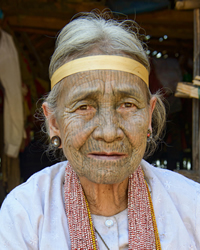Daa Yindu in Myanmar (Burma)

Photo Source:
Copyrighted © 2025
Asia Harvest-Operation Myanmar All rights reserved. Used with permission |
Send Joshua Project a map of this people group.
|
| People Name: | Daa Yindu |
| Country: | Myanmar (Burma) |
| 10/40 Window: | Yes |
| Population: | 16,000 |
| World Population: | 16,000 |
| Primary Language: | Language unknown |
| Primary Religion: | Christianity |
| Christian Adherents: | 60.00 % |
| Evangelicals: | 20.00 % |
| Scripture: | Unspecified |
| Ministry Resources: | No |
| Jesus Film: | No |
| Audio Recordings: | No |
| People Cluster: | Kuki-Chin-Mizo (Zo) |
| Affinity Bloc: | Tibetan-Himalayan Peoples |
| Progress Level: |
|
Identity
The Daa Yindu are one of the most undeveloped tribes in Myanmar. Their region is rugged and largely inaccessible except on foot. The Daa Yindu have been almost completely neglected in historical accounts, and they have never been included in any Christian lists of people groups until now. The word "Yindu" is derived from the Burmese words “yin” (chest) and “du” (knee), signifying that Daa Yindu women cover their bodies from their chests down to their knees. The Burmese likely took note of the Daa Yindu style of clothing because, prior to the 20th century, many of the other tribes in the area wore little more than loin cloths or went around naked.
Location: An estimated 16,000 Daa Yindu people inhabit 50 villages in a beautiful and widespread area of Mindat District in southeast Chin State, between the towns of Kanpetlet in the north and Kyin Dway in the south. The Daa Yindu, whose villages typically consist of between 10 and 80 households, are also located across the state border in the Gangaw District of Magway Region. Some Daa Yindu live on the slopes of Nat Ma Taung, or Mt. Victoria, which rises to 10,016 feet (3,053 meters) above sea level. A small number of Daa Yindu are known to have migrated to Malaysia and the United States.
Language: The Daa Yindu language has never been studied or classified by linguists. There are slight dialect differences between different Daa Yindu subgroups in the Kanpetlet area, but not enough to create intelligibility problems. A Daa Yindu script was developed in the 2000s using the Roman orthography, but few people have ever learned how to read it.
History
The Daa Yindu are renowned for their custom of tattooing girls' faces at puberty. Only after receiving tattoos was a girl able to marry. Although about a dozen Chin tribes in Myanmar practiced face tattooing, the Daa Yindu in remote areas may be the only group that continues the tradition at the present time.
Customs
Daa Yindu women are easily recognizable by their colorful clothing, consisting of a long skirt of vivid colors that is fastened around their chests. A strap is tied around their foreheads, and they are adorned by many bracelets and necklaces, which have been handed down over many generations. Daa Yindu men are required to pay a fixed dowry to secure a wife, which typically includes one male and two female mithun (a type of large, domesticated ox), four gold and three silver earrings, and one gun. It is often impossible for a man to pay the full dowry to his wife's family in his lifetime, so the debt carries over to his children. In this way, many families have been in perpetual debt for generations.
Religion
For centuries the Daa Yindu were animists who appeased the spirit world with animal sacrifices. In the 1950s, Burmese missionaries converted some villages to Buddhism. After a while the Buddhists appear to have become frustrated by the people's slavish devotion to the spirits, so they separated their converts into “pure Buddhists” and “animist-Buddhists.” Today, Buddhist influence remains stronger among the Daa Yindu than almost any other Chin tribe.
Christianity
In the 1970s and 1980s, Baptist evangelists from other Chin tribes took the Gospel to the Daa Yindu and enjoyed strong success. By the turn of the century, 60 percent of Daa Yindu people had become Christians, with five main denominations spearheading church movements among them. Many new believers found it difficult to fully break away from the spirit worship embedded in their culture, so much effort was spent on discipleship. The advance of Christianity among the Daa Yindu has been hampered because no work has ever been done to translate the Bible into their language. Despite their size and widespread dispersion, no Gospel resources in written, video, or audio form exist in the Daa Yindu language.